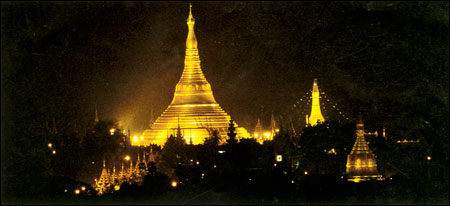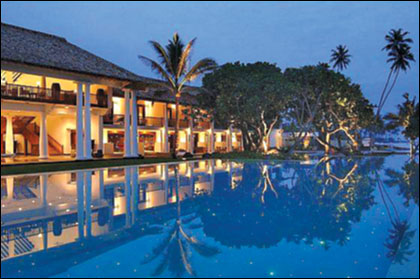|
Travel
‘Martin Wickramasinghe museum’
The ancestral home where the great writer grew up:
Ganga illeperuma in Koggala
|

On their wedding day |
Martin Wickramasinghe Trust Fund had taken a very pensive and
sensible decision by establishing folk museum complex in the house in
which he was born in Koggala, thus giving a comprehensive picture of
Martin Wicremesinghe. The Folk Museum Complex, is surrounded by
varieties of indigenous trees and shrubs in which bird life abounds. The
house and the surrounding brings to life a little part of the Koggala
which is so vividly depicted in Wickramasinghe’s writings.
Martin Wickramasinghe was born in the village of Malalagama in 1890.
A section of the ancestral home, in which he and his sisters grew up
with their parents has survived amidst rigors of time. The partly
restored house, part of the rear section which is believed to be nearly
200 years old, is a typical southern abode of the period, with pleasing
Dutch architectural features and cool, whitewashed walls and floors laid
with square bricks.
The house was taken over by the Royal Air Force during the World War
II, when all villagers in Malalagama and surrounding villages were asked
to vacate their houses within 24 hours. Most homes were demolished to
build a sea plane base (the airstrip of which is in use to this day.)
Wickramasinghe’s house miraculously escaped the fate of others in his
village. The story goes that this simple house with its charming subdued
architecture caught the eye of a female Air Force officer, and she made
it her residence during the military occupation in the area, ensuring
its preservation.
|

Martin Wickramasinghe |
|

A chekku |
It was a Catalina aircraft from this base which alerted the British
government about the presence of a Japanese fleet, in the Indian Ocean
thus alerting the military to take immediate precautionary measures to
ward off an attack.
The Folk Museum Complex, a project which the late author long had in
mind, has been brought to fruition by The Martin Wickramasinghe Trust.
It consists of five main sections:
1. The house in which Martin Wickramasinghe was born.
2. The Hall of Life.
3. The Samadhi, where his ashes had been interred
4. The Museum of Folk Culture.
5. The restored eco-environment.
The house in which Martin
Wickramasinghe was born
It has been partly renovated, whilst preserving its original
architecture. A part of the rear section of the house is thought to be
nearly 200 years old.
The Hall of Life
The Hall of Life is like an extension of the house where Martin
Wickramasinghe was born. In this section Martin Wickramasinghe’s life
and times are presented through photographs, paintings, sketches,
souvenirs, awards and memorabilia.
The Samadhi
His ashes are interred in a grass covered mound to the right of the
house. It is surmounted by a wedge shaped rock from the Koggala reef,
where he spent many hours as a child, studying on marine life. The
Samadhi is symbolic to show the extent to which he is perpetrated to the
rural culture that nurtured his intellect and
|

The Martin Wickramasinghe museum |
intuition.
The Museum of Folk Culture
The Martin Wickramasinghe Museum of Folk Culture, is a large,
spacious high-roofed building situated close to the entrance of the
complex. The museum currently holds over thousand artifacts of Sri
Lankan rural life, providing a vast and unique storehouse of knowledge
of local folk culture and folk technology going back several centuries.
The restored eco – environment
Little remains today of the picturesque Koggala which Wickremesinghe
described vividly in his writings. There is an Ambalama surrounded by
grass-covered knolls shaded by trees. Here a tired visitor may relax and
picnic in these restful surroundings, seated in comfortable benches.
“The Folk museum is an ideal place to get to know the author better,
to understand a little of what Koggala and its people meant to him.
Wickramasinghe’s writings vividly recall the carefree days of his
childhood, exploring the marine life in the Koggala reef, playing with
his friends from the village and enjoying the rural solitude of his
beloved Koggala” said Ranga Wickramasinghe, son of Martin Wickremasinghe.
The museum was opened in 1981.It was a long desire of the celebrated
writer who wanted to recapture the technological and cultural artifacts,
known to him in his childhood. Different objects of folk culture
acquired during his lifetime have been the starting point of the
collection found here.
Seated on the steps of Wickramasinghe’s ancestral home, and enjoying
the blessed charm of this seven acre piece of rural paradise, it is easy
to understand why this piece of earth nurtured and set ablaze the
imagination of one of this country’s greatest writers.
Myanmar becomes a household name
14th June, 2009 was a memorable day in the historical ties between
Sri Lanka and Myanmar since we were celebrating 50 years of diplomatic
ties between the 2 countries and what pomp and pageantry with our
President being present in Myanmar.
The historical, cultural and religious cooperation and ties between
the 2 countries dates back to the 12th century AD, when the Amarapura
Nikaya (sect) was established in Sri Lanka.

There are also historical records indicating that the King of Sri
Lanka made ties with King Anawaratha of Bagan in cultural exchanges.
Travelon Ltd, the market leaders in tour packages to this Golden Land
of Myanmar, will be making their 12th tour, just after the historical
visit by our President who was hosted by his counterpart, Senior General
Than Shwe. It is also noted that our new Ambassador to Myanmar, HE Mr.
Newton Gunarathna in a short period of less than 3 months in his new
office was able to persuade the Myanmar Government to finalize the
landmark visit by our President HE Mahinda Rajapaksa. HE U Ohn Thwin
Ambassador of Myanmar to Sri Lanka was also involved in this historic
visit.
Myanmar is a very special country for the Sri Lankans as the
Theravada (Hinayana) Buddhism practised by 90% of population of Myanmar
is similar to the Buddhism of Sri Lanka. Another important feature is
that the whole country of Myanmar (Burma) has more Buddhistic monuments
and places of worship than Boddgaya (India) and Sri Lanka put together.
The tour of Myanmar covers the world renowned Shwedagon Pagoda
(visited by our President and his entourage of 100 followers) Old Bagan
(with 4,000 Pagodas in a land area of 16 km2) Monywa (world’s tallest
Buddha statue and longest reclining Buddha statue and Sambode with
550,000 Buddha statues) Mingun (World’s biggest unfinished Dagaba and
biggest living Bell) Mandalay (with the Palace and Mahamuni Buddha
Statue) Pindaya caves (8000 statue in a limestone cave), Inle Lake (the
biggest fresh water lake at the highest elevation) and the geographical
miracle Kaihityo (Golden Rock) which is balancing on another rock.
The next tour is scheduled for 20th - 30th August. Travelon will do
their last Myanmar tour for 2009, during 9th - 20th Dec.
Fortress Hotel
A small luxury boutique resort in Koggala:
The Fortress, a luxury boutique resort nestled on the shore of the
Indian Ocean at Koggala was the best picturesque location hotel among
the down south hotels in Sri Lanka. The hotel is in a glorious location,
set right on the seaside and close to Koggala Lake, about a 20 minute
drive from Galle. What sets apart the hotel from many of its competitors
is not just its location, but its magnificent architecture and ambiance,
outside and inside.
 A
hotel fashioned in the style of a powerful fortress. When we entered the
hotel we could not see the out side because of the high walls covering
the hotel building from the out side and opening only for the Indian
Ocean giving us more privacy. A
hotel fashioned in the style of a powerful fortress. When we entered the
hotel we could not see the out side because of the high walls covering
the hotel building from the out side and opening only for the Indian
Ocean giving us more privacy.
Rising next to the beach, the resort walls enclose verdant gardens
and water features, a free flow swimming pool, wide variety of menus in
the restaurants and my room which is called the ‘Ocean Room’ gave me an
unforgettable memory. The resort’s architecture forges historic Dutch
and Portuguese styles with the motifs of Sri Lanka.
Sensual living spaces, open plan bathrooms, cutting edge
entertainment systems with plasma screens and day bed, ensures its
unparalleled luxury resort experience. Lime Spa of the Fortress offers a
range of Ayurveda treatments, Homeopathic treatments, international
therapies and tailored treatments to stay tuned by using deep relaxation
techniques. This spa specializes in traditional Ayurvedic treatments and
let’s not forget the culinary and gourmet aspects, be that the main
restaurant lounge by the pool.
There are 47 guest rooms decorated with a colonial effect and modern
finish. There are five choices, each with its own different views which
are The Fortress Room, The Beach Room, The Ocean Room, The Ocean Loft
and The Residence.
Guests can lounge in their daybed and admire the beautiful views of
either the garden or the ocean from thrir own room. Alternatively, spend
time relaxing by the pool and fully absorb the laid-back atmosphere of
this peaceful retreat.
The gardens are beautifully landscaped and scattered with day beds
and hammocks for real relaxation - perhaps after you have refreshed
yourself in the pool or in the yoga pavilion or in the well equipped
gym.
Throughout the hotel well enjoyed a touch of funky flair from
brightly coloured “egg” chairs to suspended armchairs floating between
neon lights. Modernity never overpowers style and the large infinity
pool has the most tranquil setting by night and transforms into a
magical sparkling pool.
Stroll through the grounds to the beach and watch local stilt
fishermen making their daily catch. The stilt fishermen are literally on
the doorstep and are a magnificent sight. Sunbathing below them can be a
little off putting but only before 6-10am and after 4pm. The beach is
very narrow and sunset walks are better taken further down the
coastline. If guests visit this resort they can visit the turtle
hatchery, Peace Pagoda and Galle Fort too.
It was a great and unforgettable day in my life at the Fortress
hotel. We had a great holiday experience staying at the Fortress hotel.
This lovely hotel provided us the luxury of relaxation with well
picturesque atmosphere indeed.
GI
Maldivian Food Fest at GFH
The Maldivian Food Festival which began at the Galle Face Hotel on
July 26, to coincide with the Maldivian National Day, is well attended
by not only hotel guests, but Colombo’s elite in business and diplomatic
community.
The sea Spray Restaurant of the Galle Face Hotel, located on the
water front of the ocean where the festival is being held, is gaily
decorated reminiscent of the Maldive Islands. |



